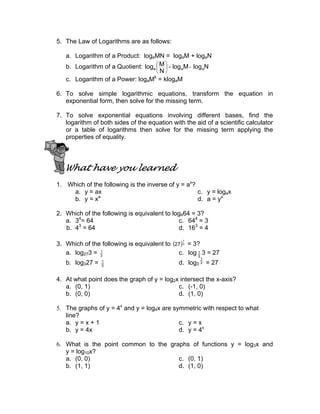Module 4 exponential and logarithmic functions
- 1. Module 4 Logarithmic Functions What this module is about This module deals with the definition, graph, properties, laws and application of the laws of the logarithmic function; and how to solve simple logarithmic equation. As you go over the discussion and exercises, you will appreciate the importance of this function. Find enjoyment in learning this module and go over the discussion and examples if you have not yet mastered a concept. What you are expected to learn This module is designed for you to: 1. define the logarithmic function f(x) = logax as the inverse of the exponential function f(x) = ax , 2. draw the graph of the logarithmic function f(x) = logax, 3. describe some properties of the logarithmic function from its graph; 4. apply the laws of logarithms; and 5. solve simple logarithmic equations. How much do you know 1. What is the inverse of the exponential function? a. Linear function b. Quadratic function c. Polynomial function d. Logarithmic function 2. Which of the following is equivalent to log216 = 4? a. 24 = 16 b. 42 = 16 c. 162 = 4 d. 164 = 2 2. Which of the following is equivalent to ( )3 1 125 = 5? a. log1255 = 3 1 b. log5125 = 3 1 c. log 3 1 5 = 125 d. log5 3 1 = 125
- 2. 4. The graph of y = log5x is asymptotic with which of the following lines? a. y = x b. x - axis c. y - axis d. y = 1 5. The graphs of y = 10x and y = log10x are symmetric with respect to what line? a. y = x + 1 b. y = 2x c. y = x d. y = 2x 6. What is the point common to the graphs of functions in the form y = logax? a. (0, 0) b. (1, 1) c. (0, 1) d. (1, 0) 7. Write log3x2 + log3y3 – log3z as a single logarithm. a. log3 • z yx 32 b. log3(x2 + y3 - z) c. log3 + z yx 32 d. none of the above 8. Simplify log318 + log32 – log34 as a single number. a. 16 b. 9 c. 3 d. 2 9. Given: log102 = 0.3010, log103 = 0.4771, and log105 = 0.6990, what is log10 1.2? a. 0.2054 b. 0.0791 c. 1.1132 d. -0.5553 10. Determine the value of x if log7x = - 2. a. 14 b. 14 1 c. 49 d. 49 1 What you will do Lesson 1 Logarithmic Function In the previous module, you have learned about inverse functions. Recall that when the domain of one function is the range and the range is the domain of the other then they are inverses. Remember also that to determine the inverse of
- 3. a function given an equation you have to interchange x and y then solve for y. Look at the illustration below on how to find the inverse of the exponential function, y = ax . Exponential Function Inverse function y = ax x = ay You will notice that the inverse of the exponential function shows that “y is the exponent to which the base a is raised in order to obtain the power x”. The inverse of the exponential function above is called logarithmic function. The function is defined by the equation - x = ay or y = logax (a>0, a ≠ 1, x > 0) The equation of a logarithmic function is read as “y is the logarithm of x to the base a”. Take note that in the notation, a is the base, x is the power and y is the exponent to which a is raised in order to obtain x. Example 1. The logarithmic equation 2 = log749 is read as “2 is the logarithm of 49 to the base 7” or “the logarithm of 49 to the base 7 is 2” which means that the exponent of 7 in order to get 49 is 2. Example 2. The logarithmic equation log6108 = 3 is read as “the logarithm of 108 to the base 6 is 3” or “3 is the logarithm of 108 to the to the base 6” meaning the exponent of 6 is 3 to get 108. Notice from the notation above that y = logax is equivalent to x = ay . Thus, an equation in exponential form can be expressed in logarithmic form and vice- versa. Study the examples that follow. Example 3. Transform the following equations in logarithmic form. 1. 26 = 64 2. 9 1 3 2- = 3. ( ) 2128 7 1 = Solutions: 1. In 26 = 64, the base is 2, the exponent is 6 and the power is 64. Thus, 26 = 64 is equivalent to 6 = log264 or log264 = 6. Exponent Base Power
- 4. 2. In 9 1 3 2- = , the base is 3, the exponent in -2 and the power is 9 1 . Hence, 9 1 3 2- = is equivalent to -2 = 9 1 log3 or 9 1 log3 = -2. . 3. In ( ) 2128 7 1 = , the base is 128, the exponent is 7 1 and the power is 2. Therefore,( ) 2128 7 1 = is equivalent to 7 1 = log1282 or log1282 = 7 1 . Example 4. Transform the following logarithmic equations to exponential form. 1. log51 = 0 2. log10.0001 = -4 3. logca = -b Solutions: 1. In log51 = 0, the base is 5, the exponent is 0, and the power is 1. Therefore, log51 = 0 is equivalent to 50 = 1. 2. In log100.0001 = -4, the base is 10, the exponent is -4, and the power is 0.0001. Thus, log100.0001 = -4 is equivalent to 10-4 = 0.0001. 3. In logca = -b, the base is c, the exponent is -b, and the power is a. Hence, logca = -b is equivalent to c-b = a. Logarithms can be obtained by considering the corresponding exponential form of the expression. Example 5. Evaluate the logarithms of the following: 1. log464 2. log927 3. 625 1 log5 Solutions: 1. Let log464 = x. Transform it in exponential form then solve for x. 4x = 64 4x = 43 x = 3 ∴log464 = 3 2. Let log927 = x. Transform it in exponential form then solve for x. log927 = x 9x = 27 (32 )x = 33
- 5. 32x = 33 2x = 3 2 3 x = ∴ log927 = 2 3 3. Let 625 1 log5 = x. Transform it in exponential form then solve for x. 625 1 log5 = x 5x = 625 1 5x = 5-4 x = -4 ∴ 625 1 log5 = -4 Try this out A. Write the equivalent exponential form of the following. 1. log232 = 5 2. log381 = 4 3. log1212 = 1 4. log 10100000 = 5 5. log1/5125 = -3 6. log464 = 3 7. log2 16 1 = -4 8. logrt = p 9. logap = s 10.logqp = m B. Write the equivalent logarithmic form. 1. 35 =243 2. 90 = 1 3. 112 = 121 4. ( ) ( )81 164 3 2 = 5. ( ) 3 4 9 16 2 1 = 6. 36 12 6 =− 7. a-5 = 5 a 1 8. 4=162 1 9. 1252/3 = 25 10.642/3 = 16 C. Evaluate the logarithm of each of the following 1. log981 2. log2128 3. log7343 4. log25625 5. log81 6. log48 7. log644 8. 216 1 6log 9. log4 256 1 10. 5 8 64log
- 6. Lesson 2 Graphs of Logarithmic Function From a previous module, you have learned about the graphs of inverse functions, that is, the graphs of inverse functions are reflections of each other and that they are symmetrical about the line y = x. Thus, the graph of the logarithmic function y = logax can be obtained from the graph of the exponential function y = ax . To do this, simply flip the graph of y = ax along the line y = x. Example 1. Draw the graph of y = log2x . Solution: To draw the graph of y = log2x, recall the graph of y = 2x . Flip the graph of y = 2x about the line y = x. You should be able to observe that the two graphs contain the following integral values. For example, the point (1, 2) is on the graph of y = 2x and the point (2, 1) is on the graph of y = log2x. Observe now that the graph of y = log2x is a reflection of the graph of the exponential function y = 2x along the line y = x which is the axis of symmetry. This can be seen in the figure below. Figure 1 x -3 -2 -1 0 1 2 3 y = 2x 8 1 4 1 2 1 1 2 4 8 x 8 1 4 1 2 1 1 2 4 8 y = log2x -3 -2 -1 0 1 2 3 -4 -3 -2 -1 0 1 2 3 4 5 6 7 8 9 -4 -3 -2 -1 0 1 2 3 4 5 6 7 8 9 y = x y = 2x y = log2x
- 7. -4 -3 -2 -1 0 1 2 3 4 5 6 7 8 9 -4 -3 -2 -1 0 1 2 3 4 5 6 7 8 9 To draw the graph of y = ( )x 2 1 and its inverse y = log 2 1 x, follow the steps in the previous example, that is, draw the graph of y = ( )x 2 1 then flip it along the line y = x. Observe that the graph of y = log 2 1 x contain the following integral values shown below. Figure 2 Notice that just like in Figure 1, the graph of y = log 2 1 x is a reflection of the graph of y = ( )x 2 1 . The two graphs are also symmetrical about the line y = x. Try this out A. Sketch the graph of each of the following logarithmic functions using the graph of its inverse. 1. f(x) = log3x 2. f(x) = log4x 3. f(x) = log5x 4. f(x) = log1/3x 5. f(x) = log1/4x 6. f(x) = log1/5x B. Compare and contrast the graphs of numbers 1 and 4, numbers 2 and 5, and numbers 3 and 6. x -3 -2 -1 0 1 2 3 y = 2x 8 4 2 1 2 1 4 1 8 1 x 8 4 2 1 2 1 4 1 8 1 y = log2x -3 -2 -1 0 1 2 3 y = x y = ( )x 2 1 y = log 2 1 x
- 8. -4 -3 -2 -1 0 1 2 3 4 5 -2 -1 0 1 2 3 4 5 6 7 8 9 Lesson 3 Properties of the Graph of a Logarithmic Function From Figure 1 in Lesson 2, you can see the properties of the graph of the logarithmic function y = log2x. Observe that the domain is the set of all positive real numbers and the range are all real numbers. It has an x-intercept (1. 0) and its asymptote is the y-axis. Notice also that the function is positive for all x greater than 1 and negative for all x less than 1. Thus, this function is increasing. Figure 1 The properties of the graph in figure 1 illustrates the properties of logarithmic functions in the form y = ax , a > 1. 1. The domain is the set of all positive real numbers and the range are all real numbers. 2. The x-intercept is (1. 0) and its asymptote is the y-axis. 3. The function is positive for all x greater than 1 and negative for all x less than 1. 4. The function is increasing. From Figure 2 in Lesson 2, the properties of the graph of the logarithmic function y = log1/2x can be observed. The domain is the set of all positive real numbers and the range are all real numbers. It has an x-intercept (1. 0) and its asymptote is the y-axis. Notice also that the function is negative for all x greater than 1 and positive for all x less than 1. Thus, this function is decreasing. -4 -3 -2 -1 0 1 2 3 4 0 1 2 3 4 5 6 7 8 9 y = log2x y = log 2 1 x
- 9. The properties of the graph in figure 1 illustrates the following properties of logarithmic functions in the form y = ax , 0 < a < 1. 1. The domain is the set of all positive real numbers and the range are all real numbers. 2. The x-intercept is (1. 0) and its asymptote is the y-axis. 3. The function is negative for all x greater than 1 and positive for all x less than 1. 4. The function is decreasing. Try this out A. Enumerate the properties of the graphs of the following logarithmic functions. Refer to the graphs drawn in Lesson 2. 1. f(x) = log3x 2. f(x) = log4x 3. f(x) = log5x 4. f(x) = log1/3x 5. f(x) = log1/4x 6. f(x) = log1/5x B. Give the properties common to the graphs in A. Lesson 4 Laws of Logarithms Since logarithmic function and exponential function are inverse functions, the laws of exponents will be used to derive the laws of logarithms. The laws of logarithms were important tools in shortening complicated computations long before the use of scientific calculators and computers. Nowadays, logarithms are used for different purposes specifically in sciences. A. The Logarithm of a Product Let M = ax and N = ay . By Law of Exponents for Products, MN = ax •ay = ax + y . By definition of logarithmic function, M = ax ↔ logaM = x, N = ay ↔ logaN = y, and
- 10. MN = ax + y ↔ logaMN = x + y. By substitution, logaMN = logaM + logaN. From the derivation, the logarithm of the product of two numbers is the sum of the logarithms of the two factors. B. The Logarithm of a Quotient Use the given in A and the Law of Exponents for Quotients, y-x y x a a a N M == . By definition of logarithmic function, M = ax ↔ logaM = x, N = ay ↔ logaN = y, and y-x a N M = ↔ y-x N Mloga = By substitution, NlogMlog N Mlog aaa -= From the derivation, the logarithm of the quotient of two numbers is the difference of the logarithms of the dividend and the divisor. C. The logarithm of a Power Let M = ax . By the Law of Exponents for a Power, Mk = (ax )k . By definition of logarithmic function, M = ax ↔ logaM = x, and Mk = (ax )k ↔ logaMk = xk. By substitution, logaMk = klogaM From the derivation, the logarithm of the kth power of a number is k times the logarithm of the number. Below are examples of the application of the laws of logarithms. Example 1. Simplify the following using the laws of logarithms. 1. loga5PQ 2. 5 32loga 3. logb(24)3 4. logb 3 7 y x
- 11. Solutions: 1. Apply the logarithm of a product. loga5PQ = loga5 + logaP + logaQ 2. Apply the logarithm of a quotient. 5 32loga = loga32 – loga5 3. Apply the logarithm of a power. logb(24)3 = 3logb24 4. Apply the logarithm of a power and logarithm of a quotient and distributive property. logb 3 7 y x = 3 1 7 y xlogb = y xlog 7 b 3 1 = 3 1 ( logbx7 – logby) = 3 1 logbx7 - 3 1 logby = 3 1 (7logbx) - 3 1 logby = 3 7 logbx - 3 1 logby Example 2: Write the following as a single logarithm. Simplify if possible. 1. log412p + 9log4q 2. logd(h2 – 16) – log4(h + 4) Solution: 1. The expression is an application of the logarithm of a power and logarithm of a product. log412p + 9log4q = log412p + log4q9 = log4(12pq9 ) 2. The expression is an application of the logarithm of a quotient. logd(h2 – 16) – logd(h + 4) = + 4h 16-hlog 2 d
- 12. = + + 4h 4)4)(h-h( logd = logd(h – 4) Example 3: Given that log 2 = 0.3010, log 3 = 0.4771, and log 5 = 0.6990, determine- 1. log 15 2. log 0.4 3. log 3.6 4. log 4 625 5. 2 30 log 3 Solution: Observe that no base was indicated in example 3. When no base is indicated, it means that the base is 10. By convention, when base 10 is used we write log x instead of log10x. We call this common logarithm. Thus, we will use this convention from now on. 1. log 15 = log (3•5) = log 3 + log 5 = 0.4771 + 0.6990 = 1.1761 2. log 0.6 = 5 3log = log 3 – log 5 = 0.4771 – 0.6990 = -0.2219 3. log 3.6 = 5 18 log = 5 32 log 2 • = log 2 + log 32 – log 5 = log 2 + 2log3 – log 5 = 0.3010 + 2(0.4771) – 0.6990 = 0.3010 + 0.9542 – 0.6990 = 0.5562 4. log 4 625 = ( )4 1 125log = log( )4 1 3 5 = 4 3 5log = 5log 4 3 = ( )6990.0 4 3 = 0.52425
- 13. 5. 2 30 log 3 = 2log-30log3 = ( ) 2log532log -3 1 •• = 2log-)5log3log2(log 3 1 ++ = 0.3010-)6990.04771.03010.0( 3 1 ++ = 3010.0)4771.1( 3 1 − = 0.4924 – 0.3010 = 0.1914 Try this out A. Express the following as a single logarithm and simplify: 1. log2192 + log26 2. log336 + log34 – log316 3. log5 3 625 4. log798 + 2log77 – log72 5. 2log-18log27log 6 1 333 + 6. log2x + 3 log2y – log2z 7. log (3x2 + 11x – 20) – log (3x – 4) 8. logb(2x -5) + logb(x + 1) 9. 2logax3 + 3logay + 4logaz - 3logaw 10. )2xlog(3)4-xlog( 2 1 2 ++ B. Given log 3 = 0.4771, log 5 = 0.6990, and log 7 = 0.8451, evaluate the following applying the laws of logarithms: 1. log 21 2. log 63 3. log 4.2 4. log 492 5. 4 45log 6. 7 75 ogl 7. 9 49 log 8. 5 2175 log 4 9. ( ) 27 21 log 2 10. 5 147 log
- 14. C. If z = log 5, write the following expressions in terms of z: 1. log 25 2. log56 3. 125 1 log 4. log 25 5. log 5000 Lesson 5 Logarithmic Equations Logarithmic equations are equations involving logarithmic functions. From previous lesson, you learned that exponential functions and logarithmic functions are inverses. Hence, the properties of these functions can be used to solve equations involving these two functions. Study the following examples illustrating how logarithmic equations are solved. Example 1: Solve the missing terms in the following logarithmic equations. 1. log6216 = x 2. logx81 = 3 2 3. log25x = 2 3 4. log4(5x + 4) = 3 5. log (2x2 + 4x – 3) = log (x2 + 2x + 12) Solutions: 1. Transform log6216 = x in exponential form, then solve for x. 6x = 216 6x = 63 x = 3 Check: If x = 3, then 63 = 216. ∴log6216 = 3 and x = 3. 2. Transform logx81 = 3 2 in exponential form, then solve for x using the properties of exponents. 81x3 2 =
- 15. 4 3x3 2 = ( )2 32 3 3 2 4 3x = Raise both sides to the same power and x = 36 simplify x = 729 Check: If x = 729, then ( ) 8133729 46 3 2 3 2 === . ∴x = 729. 3. Transform log25x = 2 3 in exponential form, then solve for x using the properties of exponents. 2 3 25x= ( )2 3 2 5x= x = 53 x = 125 Check: 25 2 3 = ( ) 12555 32 2 3 == ∴ x = 125. 4. Transform log4(5x + 4) = 3 in exponential form, then solve for x. 5x + 4 = 43 5x + 4 = 64 5x = 64 – 4 5x = 60 12 60 x= x = 5 Check: If x = 5, then log4[5(12) + 4] = log4(60 + 4) = log464 = 3. ∴ x = 5 5. log (2x2 - 7x – 9) = log (x2 - 9x + 6) Since both sides of the equation are in base 10, then 2x2 - 7x – 9 = x2 - 9x + 6 2x2 - 7x – 9 – (x2 - 9x + 6) = 0 Addition Property of Equality x2 + 2x - 15 = 0 Simplify (x + 5)(x - 3) = 0 Factoring x + 5 = 0 or x - 3 = 0 x = -5 or x = 3
- 16. Check: If x = -5, then log (2x2 - 7x – 9) = log [2(-5)2 - 7(-5) – 9] = log [2(25) + 35 – 9] = log (50 + 35 – 9) = log 76 and log (x2 - 9x + 6) = log [(-5)2 - 9(-5) + 6] = log (25 + 45 + 6) = log 76. Hence, x = -5 is a solution If x = 3, then log5 log (2x2 - 7x – 9) = log [2(3)2 - 7(3) – 9] = log [2(9) – 21 – 9] = log (18 – 21 – 9) = log (-12) Hence, x = 3 is not a root since logarithms is defined only for positive number. ∴x = -5 is the only solution. Notice that to solve problems 1 to 4 the logarithmic equations were first transformed to exponential form. Example 2: Solve for x in the following exponential equations: 1. 5x = 9 2. 3x + 7 = 2x Solutions: Exponential equations involving different bases can be solved with the use of logarithms and the aid of a scientific calculator or a table of logarithms. In the case of the example 2, a scientific calculator will be used. 1. 5x = 9 log 5x = log 9 Get the logarithm of both sides. xlog 5 = log 9 Logarithm of a Power 5log 9log x= Multiplication Property of Equality 6990.0 9542.0 x = Replacement of value from the table or calculator x = 1.3651 Division Fact Check: Using a scientific calculator, 51.3651 = 9 (rounded to the nearest whole number)
- 17. 2. 3x + 2 = 2x log 3x + 2 = log 2x Get the logarithm of both sides (x + 2)log 3 = x log 2 Logarithm of a Power x log 3 +log 3 = x log 2 Distributive Property x log 3 – x log 2 = -2log 3 Addition Property of Equality x(log 3 – log 2) = -2log 3 Factoring 2log-3log 3log2 x − = Multiplication Property of Equality 0.3010-0.4771 2(0.4771)- x = Replacement of value from the table or calculator 1761. 9542.0 x − = Multiplication Fact x = -5.4185 Division Fact Check: Using a scientific calculator, 3-5.4185 + 2 = 2-5.4185 3-3.4185 = 2-5.4185 0.0234 = 0.0234 Try this out A. Solve for the missing term: 1. log7n = -3 2. log4512 = x 3. logc36 = -2 4. log25r = 2 7 5. logp256 = -7 6. log8128 = y 7. log x - log 12 = 3 8. log5x5 - log5x3 = 2 9. log p – log 3 = 1 10. log2z + log22z = 3 11. log7a + log7(a - 1) = log712 12. log3y – log3(y – 2) = log32 13. log x + log (x + 1) = log 20 14. log (3x – 5) + log 2x = log 4 15. log 25x – log 5 = 2 16. log3(x2 – 16) – log3(x + 4) = 2 17. log5(m + 5) – l0g5(m + 1) = log54 18. log7(q + 4) – log73 = log7(q – 4) 19. log (14v2 + 35v) = log 3 + log (2v + 5)
- 18. 20. log (21h2 + 50h – 14) = log(3h2 + 25h + 14) B. Solve the following exponential equations using logarithms: 1. 4x = 5 2. 32x = 18 3. 5x + 1 = 9 4. 5x – 2 = 4x – 1 5. 23x + 5 = 3x Let’s Summarize 1. The inverse of the exponential function above is called logarithmic function. The function is defined by the equation, x = ay or y = logax (a>0, a ≠ 1, x > 0) read as “y is the logarithm of x to the base a” where a is the base, x is the power and y is the exponent to which a is raised in order to obtain x. 2. The graph of the logarithmic function y = logax can be obtained from the graph of the exponential function y = ax . To do this, flip the graph of y = ax along the line y = x. 3. The properties of the graph logarithmic functions in the form y = ax , a > 1 are as follow: a. The domain is the set of all positive real numbers and the range are all real numbers. b. The x-intercept is (1. 0) and its asymptote is the y-axis. c. The function is positive for all x greater than 1 and negative for all x less than 1. d. The function is increasing. 4. The properties of the graph of logarithmic functions in the form y = ax , 0 < a < 1are as follow: a. The domain is the set of all positive real numbers and the range are all real numbers. b. The x-intercept is (1. 0) and its asymptote is the y-axis. c. The function is negative for all x greater than 1 and positive for all x less than 1. d. The function is decreasing.
- 19. 5. The Law of Logarithms are as follows: a. Logarithm of a Product: logaMN = logaM + logaN b. Logarithm of a Quotient: NlogMlog N Mlog aaa -= c. Logarithm of a Power: logaMk = klogaM 6. To solve simple logarithmic equations, transform the equation in exponential form, then solve for the missing term. 7. To solve exponential equations involving different bases, find the logarithm of both sides of the equation with the aid of a scientific calculator or a table of logarithms then solve for the missing term applying the properties of equality. What have you learned 1. Which of the following is the inverse of y = ax ? a. y = ax b. y = xa c. y = logax d. a = yx 2. Which of the following is equivalent to log464 = 3? a. 34 = 64 b. 43 = 64 c. 644 = 3 d. 163 = 4 3. Which of the following is equivalent to ( )3 1 27 = 3? a. log273 = 3 1 b. log327 = 3 1 c. log 3 1 3 = 27 d. log3 3 1 = 27 4. At what point does the graph of y = log2x intersect the x-axis? a. (0, 1) b. (0, 0) c. (-1, 0) d. (1, 0) 5. The graphs of y = 4x and y = log4x are symmetric with respect to what line? a. y = x + 1 b. y = 4x c. y = x d. y = 4x 6. What is the point common to the graphs of functions y = log3x and y = log10x? a. (0, 0) b. (1, 1) c. (0, 1) d. (1, 0)
- 20. 7. Write 3 log a + 5 log b – 4 log c as a single logarithm. a. log • 4 53 c ba b. log (a3 + b5 – c4 ) c. log + 4 53 c ba d. none of the above 8. Simplify log381 + log33 – log39 as a single number. a. 27 b. 5 c. 3 d. 2 9. Given that log102 = 0.3010, log103 = 0.4771, and log105 = 0.6990, what is log 107.5? a. 0.5229 b. 0.0791 c. 0.8751 d. 1.4471 10. Determine the value of x if log5 (8x - 7) = 2 a. 4.875 b. 4 c. 3.125 d. 2.25
- 21. Answer Key How much do you know 1. d 2. a 3. a 4. c 5. c 6. d 7. a 8. d 9. b 10. d Try this out Lesson 1 A. 1. 25 = 32 2. 34 = 81 3. 121 = 12 4. 105 = 100000 5. 125 5 1 3 = − 6. 43 = 64 7. 2-4 = 16 1 8. rp = t 9. as = p 10. qm = p B. 1. log3243 = 5 2. log91 = 0 3. log11121 = 2 4. 4 81 16 log 3 2 = 5. 2 1 3 4 log 9 16 = 6. 2 36 1 log6 −= 7. 5 a 1 log 5a −= 8. 2 1 4log16 =
- 22. 9. 3 2 25log125 = 10. 3 2 16log64 = C. 1. 2 2. 7 3. 3 4. 2 5. 0 6. 2 3 7. 3 1 8. -3 9. -4 10. 5 2 Lesson 2 A. -6 -4 -2 0 2 4 6 8 10 12 14 16 18 20 22 24 26 28 30 -2 0 2 4 6 8 10 12 14 16 18 20 22 24 26 28 30 1. y = log3x y = 3x
- 23. -4 -2 0 2 4 6 8 10 12 14 16 18 -4 -2 0 2 4 6 8 10 12 14 16 18 20 -5 0 5 10 15 20 25 30 -5 0 5 10 15 20 25 30 -6 -3 0 3 6 9 12 15 18 21 24 27 30 -6 -3 0 3 6 9 12 15 18 21 24 27 30 2. y = log4x 3. y = log5x y = 4x y = 5x y = x 3 1 4. y = xlog 3 1
- 24. -4 -2 0 2 4 6 8 10 12 14 16 18 -4 -2 0 2 4 6 8 10 12 14 16 18 -4 -2 0 2 4 6 8 10 12 14 16 18 20 22 24 26 28 -4 -2 0 2 4 6 8 10 12 14 16 18 20 22 24 26 28 B. The graph of y = log3x has the same shape and size as the graph of xlogy 3 1= . The same is true for the graphs of y = log4x and xlogy 4 1= , and y = log5x and xlogy 5 1= . The graphs of y = log3x, y = log4x and y = log5x are increasing while the graphs of xlogy 3 1= , xlogy 4 1= , and y= x 4 1 5. y = xlog 4 1 y = x 5 1 6. y= xlog 5 1
- 25. xlogy 5 1= are decreasing. The six graphs have a common point (1, 0). Lesson 3 A. B. Common Properties: Domain, range, x-intercepts, and asymptotes. Lesson 4 A. 1. log232 = 5 2. log39 = 2 3. 3 4 log55= 3 4 4. 4log77 = 4 5. 2 5 log33 = 2 5 6. log z xy3 2 7. log (x+ 5) 8. logb(2x2 – 3x – 5) 9. log 3 436 a w zyx 10.log 32 )2x(4x +− B. 1. 1.3222 2. 1.7993 3. 0.6232 4. 3.3804 5. 0.4133 6. 1.03 7. -0.1091 8. 1.5066 9. 1.2131 10.1.8178 C. 1. 2z 2. 6z 3. -3z 4. z 5. z + 3 No . Equation Domain Range x-intercept Asymptote Trend 1 y = log3x + Real Nos. Real Nos. (1, 0) y-axis increasing 2 y = log4x + Real Nos. Real Nos. (1, 0) y-axis increasing 3 y = log5x + Real Nos. Real Nos. (1, 0) y-axis increasing 4 xlogy 3 1= + Real Nos. Real Nos. (1, 0) y-axis decreasing 5 xlogy 4 1= + Real Nos. Real Nos. (1, 0) y-axis decreasing 6 xlogy 5 1= + Real Nos. Real Nos. (1, 0) y-axis decreasing
- 26. Lesson 5 A. 1. 343 1 2. 2 9 3. 6 1 4. 78125 5. 2 1 6. 3 7 7. 12000 8. 5 9. 30 10.2 11.4 12.4 13.4 14.2 15.20 16.13 17. 3 1 18.8 19. 7 3 20.3 B. 1. 1.16 2. 1.32 3. 1.29 4. 8.21 5. -3.53 What have you learned 1. c 2. b 3. a 4. d 5. c 6. d 7. a 8. c 9. c 10. b



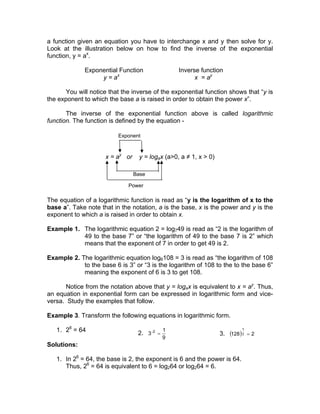

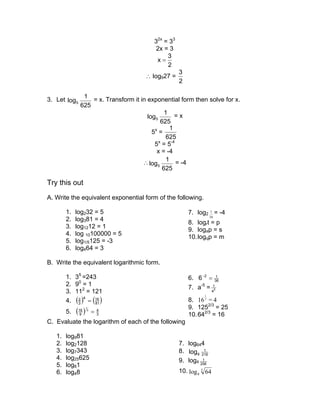
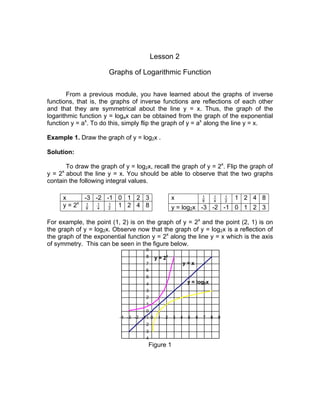

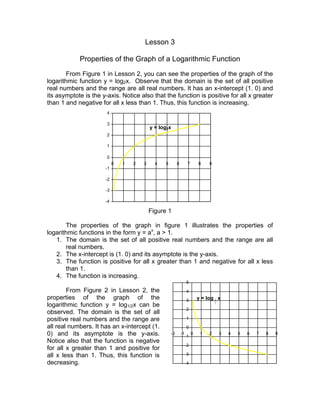
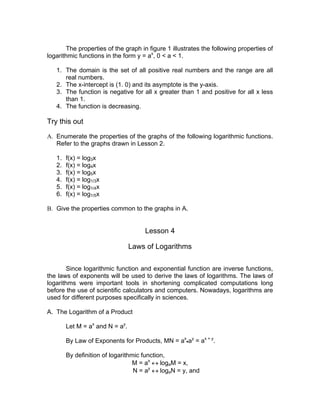
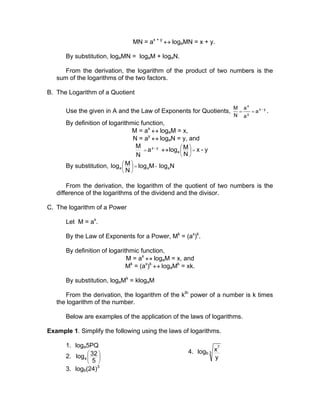
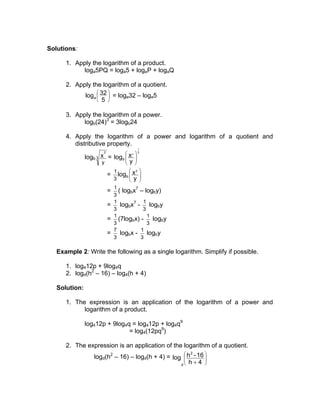



![4
3x3
2
=
( )2
32
3
3
2
4
3x =
Raise both sides to the same power and
x = 36
simplify
x = 729
Check:
If x = 729, then ( ) 8133729 46 3
2
3
2
=== .
∴x = 729.
3. Transform log25x =
2
3
in exponential form, then solve for x using the
properties of exponents.
2
3
25x=
( )2
3
2
5x=
x = 53
x = 125
Check:
25 2
3
= ( ) 12555 32 2
3
==
∴ x = 125.
4. Transform log4(5x + 4) = 3 in exponential form, then solve for x.
5x + 4 = 43
5x + 4 = 64
5x = 64 – 4
5x = 60
12
60
x=
x = 5
Check:
If x = 5, then log4[5(12) + 4] = log4(60 + 4) = log464 = 3.
∴ x = 5
5. log (2x2
- 7x – 9) = log (x2
- 9x + 6)
Since both sides of the equation are in base 10, then
2x2
- 7x – 9 = x2
- 9x + 6
2x2
- 7x – 9 – (x2
- 9x + 6) = 0 Addition Property of Equality
x2
+ 2x - 15 = 0 Simplify
(x + 5)(x - 3) = 0 Factoring
x + 5 = 0 or x - 3 = 0
x = -5 or x = 3](https://image.slidesharecdn.com/module4-exponentialandlogarithmicfunctions-130825100523-phpapp01/85/Module-4-exponential-and-logarithmic-functions-15-320.jpg)
![Check:
If x = -5, then log (2x2
- 7x – 9) = log [2(-5)2
- 7(-5) – 9]
= log [2(25) + 35 – 9]
= log (50 + 35 – 9)
= log 76
and log (x2
- 9x + 6) = log [(-5)2
- 9(-5) + 6]
= log (25 + 45 + 6)
= log 76.
Hence, x = -5 is a solution
If x = 3, then log5 log (2x2
- 7x – 9) = log [2(3)2
- 7(3) – 9]
= log [2(9) – 21 – 9]
= log (18 – 21 – 9)
= log (-12)
Hence, x = 3 is not a root since logarithms is defined only for positive
number.
∴x = -5 is the only solution.
Notice that to solve problems 1 to 4 the logarithmic equations were first
transformed to exponential form.
Example 2: Solve for x in the following exponential equations:
1. 5x
= 9 2. 3x + 7
= 2x
Solutions:
Exponential equations involving different bases can be solved with the
use of logarithms and the aid of a scientific calculator or a table of
logarithms. In the case of the example 2, a scientific calculator will be used.
1. 5x
= 9
log 5x
= log 9 Get the logarithm of both sides.
xlog 5 = log 9 Logarithm of a Power
5log
9log
x= Multiplication Property of Equality
6990.0
9542.0
x = Replacement of value from the table or
calculator
x = 1.3651 Division Fact
Check:
Using a scientific calculator,
51.3651
= 9 (rounded to the nearest whole number)](https://image.slidesharecdn.com/module4-exponentialandlogarithmicfunctions-130825100523-phpapp01/85/Module-4-exponential-and-logarithmic-functions-16-320.jpg)


